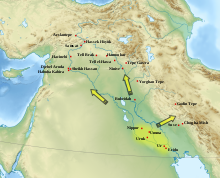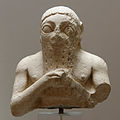Uruk
Uruk (Kuneiform: 𒌷𒀕 atau 𒌷𒀔}} URUUNUG; bahasa Sumeria: Unug; bahasa Akkadia: Uruk; bahasa Arab: وركاء, Warkā'; bahasa Aram/Alkitabiah Ibrani: אֶרֶךְ Erech; bahasa Yunani Kuno: Ὀρχόη, translit. Orchoē, Ὀρέχ Orech, Ὠρύγεια Ōrugeia) merupakan sebuah kota kuno Sumeria dan kemudian Babilonia, terletak di sebelah timur dataran yang sekarang sungai Efrat, di kanal kuno Sungai Efrat, sekitar 30 km timur Samawah modern, Al-Muthannā, Irak.[1]
𒀕𒆠, Unugki (bahasa Sumeria) 𒌷𒀕 atau 𒌷𒀔, Uruk (bahasa Akkadia) وركاء or أوروك Warkāʼ atau Auruk (bahasa Arab) | |
 Kuil Putih ziggurat di Uruk pada tahun 2020 | |
| Lokasi | Al-Warka, Kegubernuran Muthanna, Irak |
|---|---|
| Wilayah | Mesopotamia |
| Koordinat | 31°19′27″N 45°38′14″E / 31.32417°N 45.63722°E |
| Jenis | Pemukiman |
| Luas | 6 km2 (2,3 sq mi) |
| Sejarah | |
| Didirikan | milenia ke-4 SM |
| Ditinggalkan | Sekitar 700 M |
| Periode | Periode Uruk hingga Awal Abad Pertengahan |
| Catatan situs | |
| Nama resmi | Kota Arkeologis Uruk |
| Bagian dari | Ahwar Irak Selatan |
| Kriteria | Campuran: (iii)(v)(ix)(x) |
| Nomor identifikasi | 1481-005 |
| Pengukuhan | 2016 (Sesi ke-40) |
| Luas | 541 ha (2,09 sq mi) |
| Zona pembatas | 292 ha (1,13 sq mi) |

Uruk adalah tipesitus untuk periode Uruk. Uruk memainkan peran utama di dalam urbanisasi awal Sumeria di pertengahan abad ke-4 SM. Pada puncaknya skt. 2900 SM, Uruk mungkin memiliki 50,000–80,000 penduduk yang tinggal di area berdinding 6 km2 (2,32 sq mi); menjadikannya kota terbesar di dunia saat itu.[1] Raja legendaris Gilgames, menurut kronologi yang disajikan di dalam Daftar Raja Sumeria, memerintah Uruk pada abad ke-27 SM. Kota ini kehilangan kepentingan utamanya pada sekitar tahun 2000 SM, dalam konteks perjuangan Babilonia dengan Elam, namun tetap dihuni sepanjang periode Seleukia dan Parthia sampai akhirnya ditinggalkan sesaat sebelum atau setelah penaklukan Islam.
Situs Uruk dikunjungi pada tahun 1849 oleh William Kennett Loftus yang memimpin penggalian pertama dari tahun 1850 sampai 1854, dan mengenalinya sebagai "Erech", diketahui sebagai "kota kedua Nimrod".[2]
Nama Arab Babilonia, al-ʿIrāq, diperkirakan berasal dari nama Uruk, melalui transmisi Bahasa Aram (Erech) dan kemungkinan Bahasa Persia Pertengahan (Erāq).[3]
-
Lugal-kisal-si, raja Uruk
-
Topeng Warka
-
ukiran banteng, Periode Jemdet Nasr, skt. 3000 SM
Catatan
- ^ a b Harmansah, 2007
- ^ William Kennett Loftus (1857). Travels and researches in Chaldaea and Susiana: with an account of excavations at Warka, the "Erech" of Nimrod, and Shush, "Shushan the Palace" of Esther, in 1849-52. Robert Carter & Brothers.
Of the primeval cities founded by Nimrod, the son of Gush, four are represented, in Genesis x. 10, as giving origin to the rest : — "And the beginning of his kingdom was Babel, and Erech, and Accad, and Galneh, in the land of Shinar." ...let us see if there be any site which will correspond with the biblical Erech — the second city of Nimrod. About 120 miles southeast of Babylon, are some enormous piles of mounds, which, from their name and importance, appear at once to justify their claim to consideration. The name of Warka is derivable from Erech without unnecessary contortion. The original Hebrew word "Erk," or "Ark," is transformed into "Warka," either by changing the aleph into vau, or by simply prefixing the vau for the sake of euphony, as is customary in the conversion of Hebrew names to Arabic. If any dependence can be placed upon the derivation of modern from ancient names, this is more worthy of credence than most others of like nature.... Sir Henry Rawlinson states his belief that Warka is Erech, and in this he is supported by concurrent testimony.... [Footnote: See page xvi. of the Twenty-ninth Annual Report of the Royal Asiatic Society, 1852 ; and Proceedings of the Royal Geogr. Society, vol. i., page 47]
- ^ "The name al-ʿIrāq, for all its Arabic appearance, is derived from Middle Persian erāq 'lowlands'" W. Eilers (1983), "Iran and Mesopotamia" in E. Yarshater, The Cambridge History of Iran, vol. 3, Cambridge: Cambridge University Press.
Lihat pula
Referensi
- Baker, H.D. "The Urban Landscape in First Millennium BC Babylonia". University of Vienna.
- Beaulieu, Paul-Alain (2003). The Pantheon of Uruk During the Neo-Babylonian Period. BRILL. hlm. 424. ISBN 90-04-13024-1.
- Charvát, Petr; Zainab Bahrani; Marc Van de Mieroop (2002). Mesopotamia Before History. London: Routledge. hlm. 281. ISBN 0-415-25104-4.
- Crawford, Harriet E. W. (2004). Sumer and the Sumerians. Cambridge University Press. hlm. 252. ISBN 0-521-53338-4.
- Fassbinder, Jörg W. E.; Becker, Helmut; van Ess, Margarete (2003). "Magnetometry at Uruk (Iraq): the city of king Gilgamesh". Geophysical Research Abstracts. European Geophysical Society. 5 (9152): 1. Bibcode:2003EAEJA.....9152F. Diakses tanggal 2009.
- Harmansah, Ömür (2007-12-03). "The Archaeology of Mesopotamia: Ceremonial centers, urbanization and state formation in Southern Mesopotamia". Diarsipkan dari versi asli tanggal 2007-01-06. Diakses tanggal 2011-08-28.
- Oppenheim, A. Leo; Erica Reiner (1977). Ancient Mesopotamia: Portrait of a Dead Civilization. Chicago: University of Chicago Press. hlm. 445. ISBN 0-226-63187-7.
Bacaan selanjutnya
- Chisholm, Hugh, ed. (1911). "Erech". Encyclopædia Britannica. 9 (edisi ke-11). Cambridge University Press. hlm. 734–735.
- Green, MW (1984). "The Uruk Lament". Journal of the American Oriental Society. 104 (2): 253–279. doi:10.2307/602171. JSTOR 602171.
- Kuhrt, Amélie (1995). The Ancient Near East. London: Routledge. hlm. 782. ISBN 0-415-16763-9.
- Liverani, Mario; Zainab Bahrani; Marc Van de Mieroop (2006). Uruk: The First City. London: Equinox Publishing. hlm. 97. ISBN 1-84553-191-4.
- Lloyd, Seton (1955). Foundations in the Dust. New York, New York: Penguin Books. hlm. 217. ISBN 0-500-05038-4.
- Postgate, J.N. (1994). Early Mesopotamia, Society and Economy at the Dawn of History. New York, New York: Routledge Publishing. hlm. 367. ISBN 0-415-00843-3.
- Rothman, Mitchell S. (2001). Uruk, Mesopotamia & Its Neighbors. Santa Fe: School of American Research Press. hlm. 556. ISBN 1-930618-03-4.
- Vos, Howard F. (1977). Archaeology in Bible Lands. Chicago, Illinois: Moody Press. hlm. 399. ISBN 978-0-8024-0293-6.
Pranala luar
- Earliest evidence for large scale organized warfare in the Mesopotamian world (Hamoukar vs. Uruk?)
- Uruk at CDLI wiki
- Lament for Unug (sux)
- Archaeological Expedition Mapping Ancient City Of Uruk in 2002
- Digital images of tablets from Uruk - CDLI




